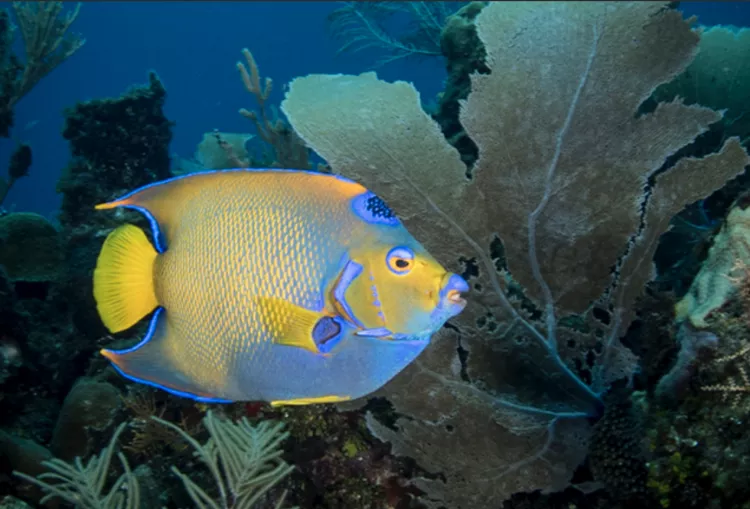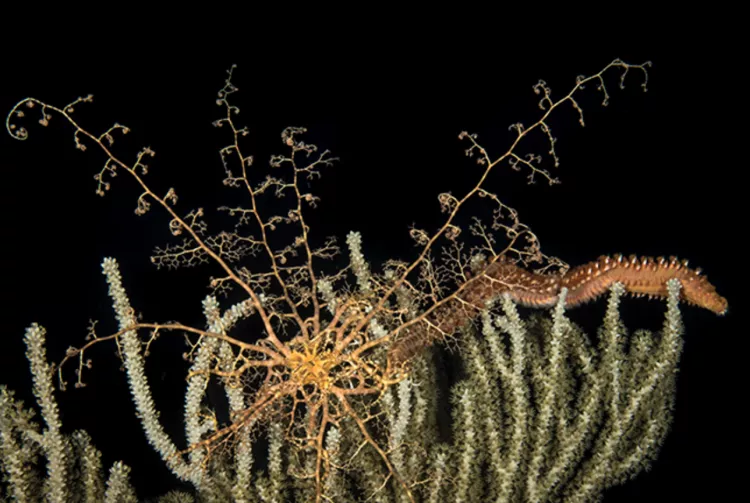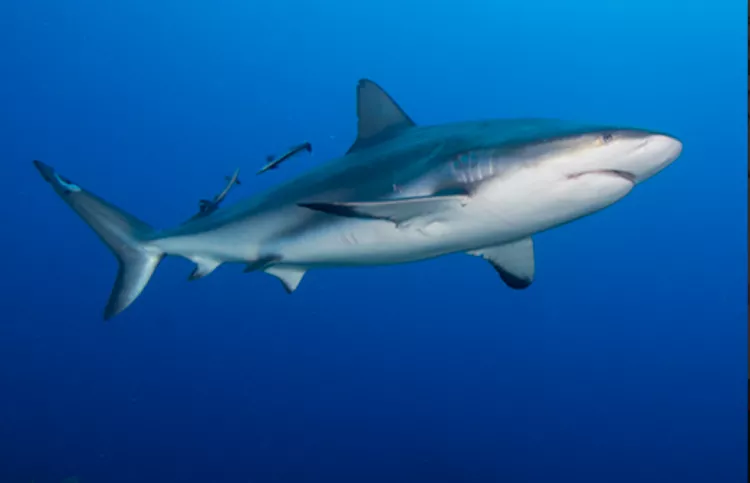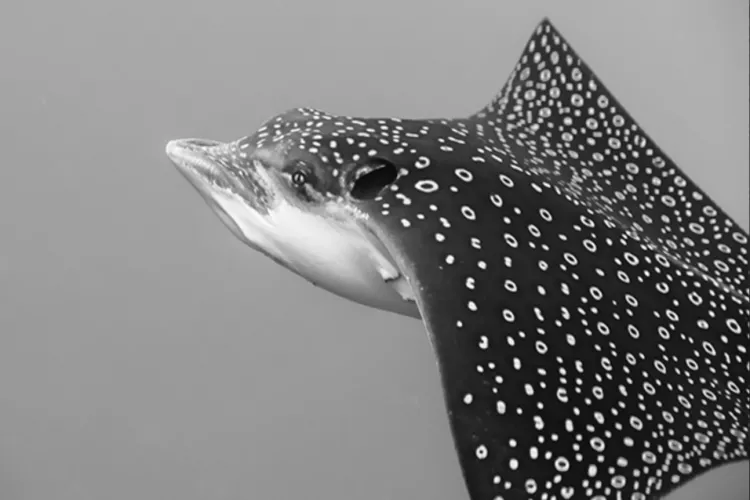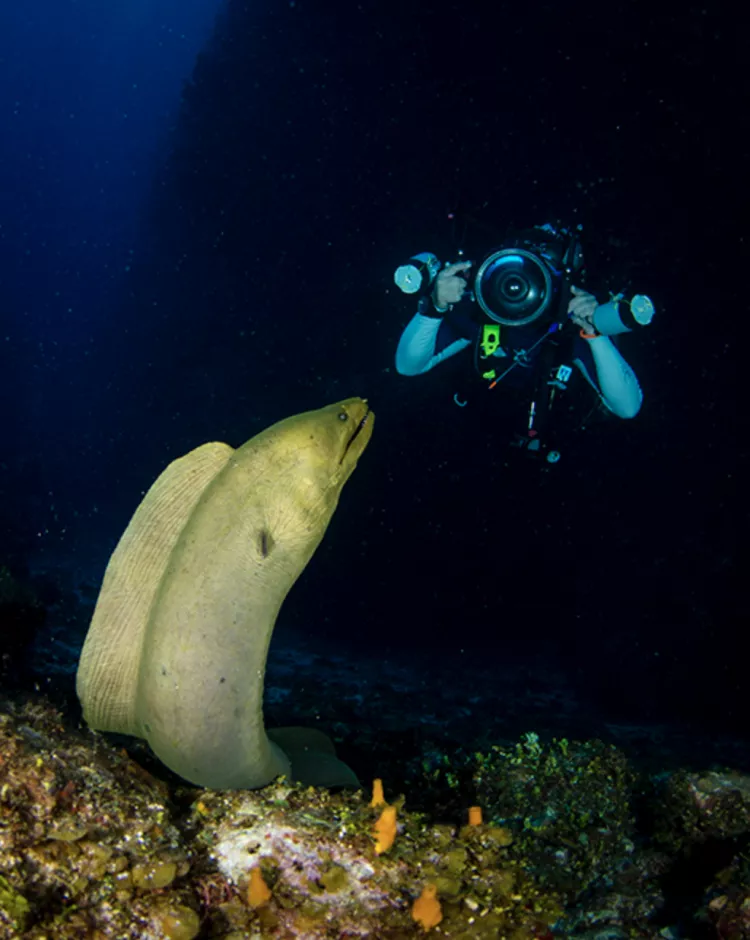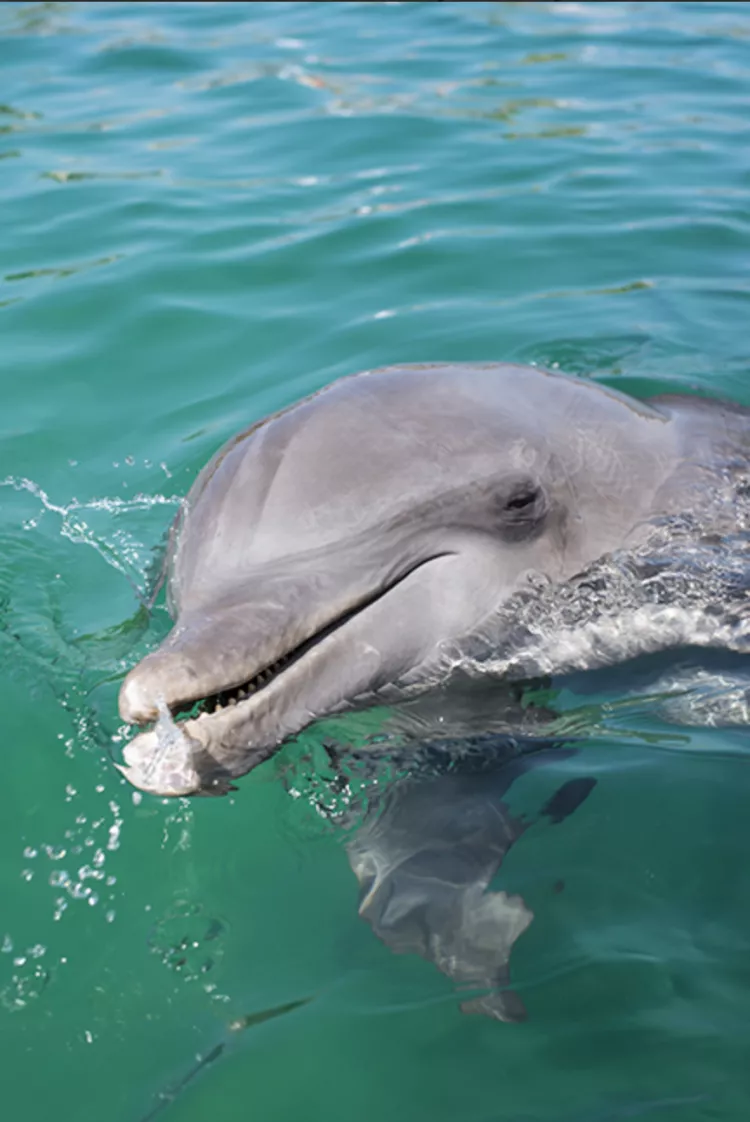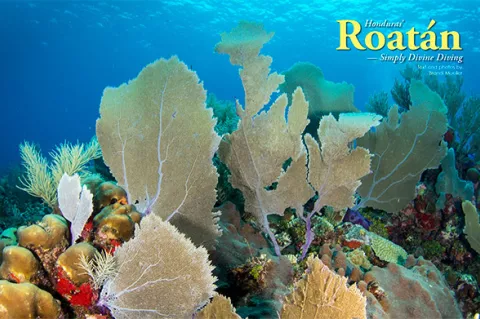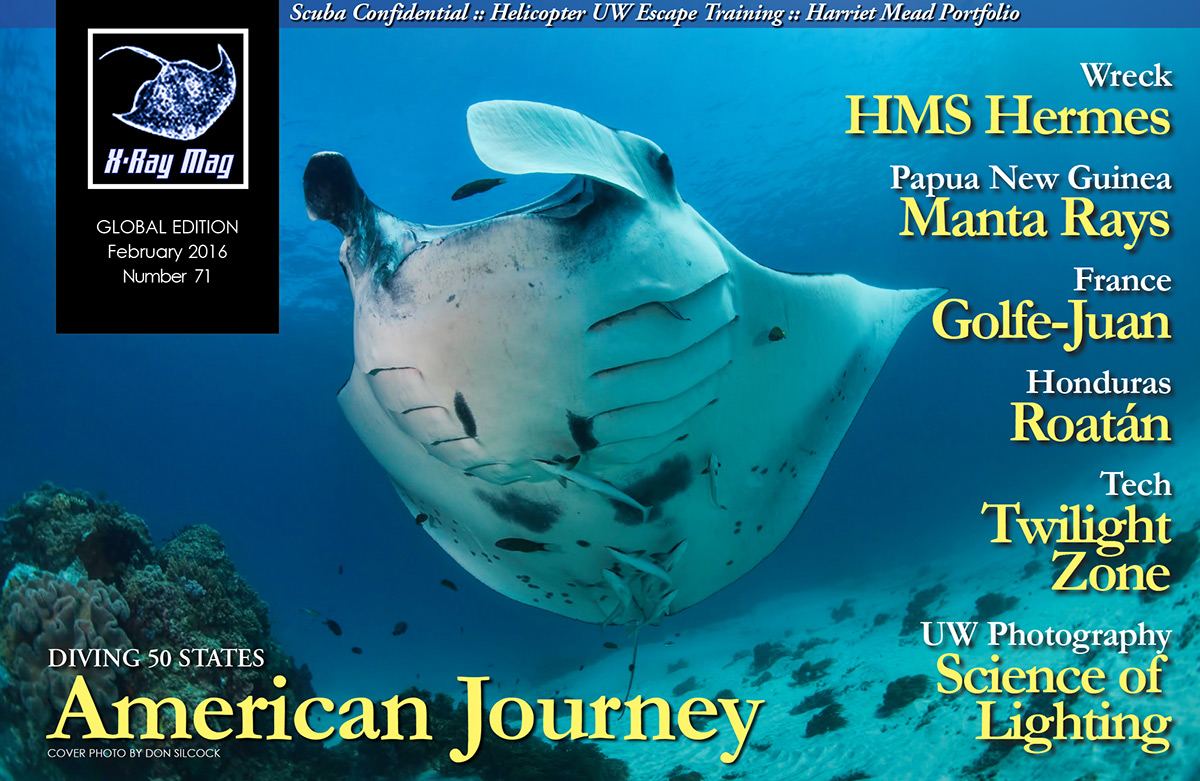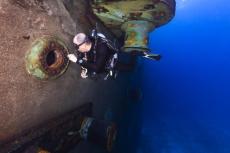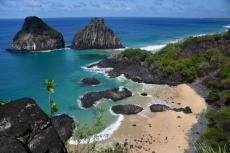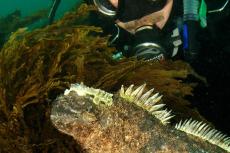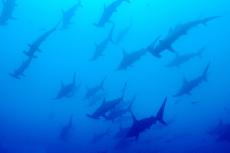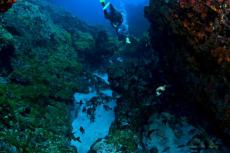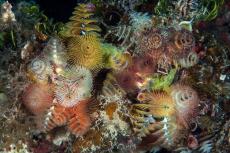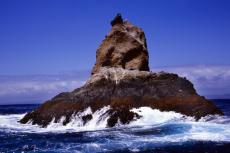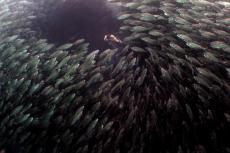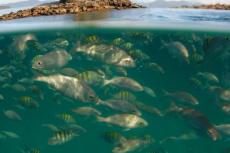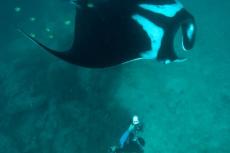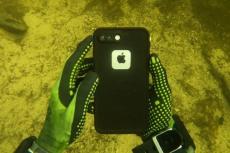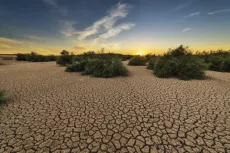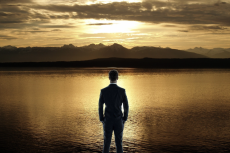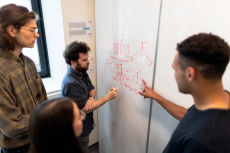It is 7:30 in the morning and I’m on my personal veranda on a small hill looking out over green trees and beyond them to blue water and a bright orange sun emerging from it. My feet are up on the rail and there’s a cup of coffee in my hand. I snap a photo for Instagram—#itdoesntgetanybetterthanthis. And the day’s diving hasn’t even started yet.
Contributed by
Factfile
Brandi Mueller is a PADI IDC Staff Instructor and boat captain living in the Marshall Islands.
When she’s not teaching scuba or driving boats, she’s most happy traveling and being underwater with a camera.
For more information, visit: Brandiunderwater.com.
References:
www.turquoisebayresort.com
www.anthonyskey.com
www.Roatanmarinepark.com
I am at Turquoise Bay Dive Resort and it embraces the meaning of tranquillo like no other. Sitting almost right at the center of the northern edge of Roatán, it’s a pleasure to escape the touristy hustle and bustle of the West End. I slowly sip my coffee and decide I should probably head to breakfast, there’s no hurry though, the dive boat is scheduled to leave around 8:30 or 9:00 a.m., so I have plenty of time to relax and enjoy the view.
Roatán
Roatán is a Honduran island part of Islas de la Bahia (the Bay Islands) which also includes Utila, Cayos Cochinos, Guanaja, and the Swan Islands. Roatán is the largest with rolling green hills 48km (30 miles) off the eastern coast of Honduras. Only 60km (37 miles) long and 5km (3 miles) wide, over 50 percent is covered in green including pine forests at higher altitudes and rainforest-like areas with ferns and palms in the valleys. Reefs that are part of the Mesoamerican Reef System surround the island, part of the world’s second largest barrier reef after the Great Barrier Reef. The Mesoamerican Reef is known for having the most marine biodiversity in the world and stretches from the Bay Islands to Mexico.
Easy to get to with flights arriving daily from several Central America and US cities, dive resorts and operations abound. If just diving isn’t enough, it’s a great location to continue diver education up through to becoming an instructor. PADI 5 Star Instructor Development Resorts seem to be found on every corner and many offer affordable work/study/stay programs. This is very obvious at the nightly gatherings at local watering holes such as Sundowner’s Beach Bar where almost everyone you meet is temporarily “living” on Roatán and about to become an instructor.
The island is pretty, with birds and butterflies, white sandy beaches and a generally laid-back attitude. What more could you ask for? How about amazing diving?
The diving
My leisurely morning continued with a fantastic huevos rancheros breakfast and I causally made my way down to the dive shop to get ready for my first dive of the day. With my gear and camera ready, we headed out to a dive site called The Labyrinth. It was getting close to hurricane season, and although Roatán isn’t in the hurricane belt, I was still feeling really lucky with the weather.
Leaving the resort, we found the ocean calm as glass. But then, the glass broke. Looking off into the blue, a pod of spinner dolphins was breaking the calm, rushing over to our boat. They played on the bow, darting back and forth, some spinning off in the distance. I couldn’t help but think what a nice morning it had been so far.
The Labyrinth. Jumping in the warm water, our group of divers were immediately greeted with pink, purple, and peach colored sea fans and sponges. A school of purple parrotfish swam past, stopping for a second for a bite to eat, and then continuing on their way. We followed the dive guide through maze-like channels of rock and coral until we reached the wall drop-off. As if on command, as we looked out into the blue, an eagle ray swam past. Returning to the boat, the captain pointed out about 200 yards to where the dolphins were still playing, and we spent our surface interval with them at the bow of the boat.
Dolphin’s Den. Our second dive was at Dolphin’s Den. This amazing site got its name from the skeleton of a dolphin found inside the cavern many years ago. No deeper than 12m (40ft), this dive site has a large cavern with tunnels throughout and plenty of natural light filtering through, sending light beams to the sea floor. Inside the cavern were schools of silversides and cardinalfish, and lobsters lived in the crevasses of the cavern. I could have spent hours inside, but the dive guide beckoned us back to the boat 70 minutes later. With the first day’s diving complete, we headed back to the resort for a relaxing evening.
Rock Star. The next morning, we headed to a dive site called Rock Star. This mini-wall was jam-packed with colorful sponges, sea fans and coral. After descending, a slight current moved us effortlessly along the wall, and we took in all the fish and marine life around us. In one area, the wall turned into a bit of a canyon with walls on both sides. Down in the sand was a huge green moray eel, completely out of the reef, looking almost as if it was standing, all six feet of it, waiting for us. He posed for photos until we’d gotten all the shots we could handle, and then we continued along the wall.
Lionfish Control Program
Back on the boat we talked about this crazy eel, and our dive guide explained why it might have been exhibiting this behavior. As the lionfish plague continues throughout the Caribbean, Roatán has done an excellent job of trying to reduce the problem. Enlisting the local community and visiting divers, the Roatán Marine Park has developed a Lionfish Control Program. Their aim is to cull the lionfish, and they have worked together with the Honduran government fishing agencies to educate and distribute spears to the community to aid in controlling populations. A lionfish license must be obtained, and local community members are further encouraged to hunt lionfish to sell to popular restaurants where lionfish is on the menu.
Green moray eels have adapted to these lionfish hunters and learned there is a tasty treat at the end of the spear, which is sometimes shared with the eels. On several sites through my week, we came across very friendly eels interacting with divers and coming very close in hopes of a lionfish dinner. I’m always intrigued how every slight impact humans have on the ocean leads to behavioral changes we didn’t expect.
While getting rid of the lionfish is a good thing, eels in close contact with divers may have mixed results. They make for fantastic photo subjects, but it’s a good idea to be aware of where your fingers are, lest they become mistaken for eel food.
The impact of the Lionfish Control Program is very visible on the reefs compared to other Caribbean islands. It’s almost difficult to find a lionfish, which is fantastic. However, it has been discussed that the lionfish population may unfortunately be adapting to this shallow-water hunting and are just moving to deeper waters.
More diving
The next day, we drove around the island for a chance to dive the south shore. My first and only prior visit to Roatán was ten years ago, and when the dive guide told us he was taking us to his favorite site, Mary’s Place, bells and whistles went through my head. I remembered this specific dive site after all these years, and couldn’t wait to get underwater and see it again.
Mary’s Place. Deep cracks with marine life draping the walls go down past 100ft with canyon swim-throughs so skinny that only one diver at a time can fit in. We wound our way through the cracks, being sure not to run into any of the delicate marine life coating the wall. Back on the boat, I remember why I’d loved this site so much the last time I was here.
Roatán’s diving is diverse. There are wall dives, canyons, caverns, shallow reef dives, wrecks, sharks, dolphins and night dives. The reefs are healthy, with plenty of life, and you’d have to try really hard not to see sharks, turtles or rays on any given dive. Just when I thought I had seen all of Roatán’s beauty in reef fish, large sea fans and huge barrel sponges, I realized there was plenty more to see than just reefs.
Wreck dives
Roatán has several fantastic wrecks that were artificially sunk for divers. Near the northwestern side of the island is the El Aguila, a 64m (210ft) cargo vessel. It sits with the ship’s hull in the sand at around 30m (100ft) and has attracted many large and friendly groupers. In the sand around the bow, we found turtles feasting on sea grass and an eagle ray. As we moved past the ship into the shallows, there was a beautiful reef with several green moray eels.
The largest wreck sunk in Roatán is the Odyssey, a 90m (300ft) multistory wreck that can be found in the sand from 12-35m (40-110ft) on the northern coast. Another Roatán wreck is the Prince Albert, which is a 42m (140ft) tanker that was sunk on the southern shore. This wreck is covered in healthy coral growth and attracts plenty of marine life.
Bottlenose dolphin dives
While I have mixed feelings about diving with captive animals, Anthony’s Key Resort is home to the Roatán Institute for Marine Science (RIMS) and they offer diving and learning interactions with bottlenose dolphins. I decided it would be best to see what was going on before judging, so I participated in a dolphin dive.
RIMS’ research includes dolphin behavior and health studies as well as an “open water program”, which involves seven dolphins that are taken out of the enclosure daily and brought to a nearby reef where divers can see the animals in open water.
The dive started on floating docks surrounding one of the two large lagoon enclosures that RIMS has for their dolphins. A trainer introduces divers to one of the dolphins, many of which have been born at RIMS, and the dolphin we met put on a little bit of a show letting us rub its back, and he showed off a bit with a few flips.
We then took a short, five-minute boat ride out of the lagoon area and jumped in the water for a dive. We descended to around 20m (60ft) and were told to stay in a circle sitting or kneeling on the sandy bottom. The anticipation built as we kept looking around and waiting for the two dolphins that were supposed to join us. None showed up for over ten minutes.
Just as I was starting to think maybe they didn’t want to hang out that day, like a lightening flash, one of the dolphins whizzed by us in a jet of exhaled bubbles from his blowhole. As quickly as he showed up, he was gone, leaving us looking up, down, and all around again. And then he came back and there was another dolphin with him.
With a maximum time set at 45 minutes for the dive, it seemed from then on that time just flew by. The dolphins swam up close to us, between us and all around us. Slowing down and speeding up, they looked like they were having a good old time showing off for the humans. When the dive guide told us it was time to come up, we slowly started to ascend, but very slowly… so we could spend more time with the dolphins.
While I still would rather see all animals in their natural environments and not in captivity, I am torn, because I also believe programs like this can help to educate the masses, many of whom might never get the chance to come across a bottlenose in its wild habitat. For both children and adults to see these amazing animals up close can lead to more people loving them and caring about their welfare and their ocean habitat that is so greatly at risk right now. No one will try to save something they know nothing about.
For the rest of the day, you couldn’t wipe the smile off my face. You can’t help but love dolphins, and I think that some good can come from programs such as this one where the animals are properly cared for and have adequate enclosures. Obviously, the animal’s well-being is the most important thing, but I think (and truly hope) there is a right way to do things like this.
Shark dive
All the pretty reefs and beautiful marine life was starting to get a bit too “tranquillo” for me, so the dive shop suggested I head over to Coxen Hole for a shark dive at the western tip of the island. The site is known for close encounters with many large female grey Caribbean reef sharks showing up daily for the fish snacks the dive shop puts out for them.
Before I knew it, I was underwater at about 25m(80ft) kneeling in the sand in a sort of ocean-made auditorium with a coral-covered rock wall behind me and about 25 sharks putting on a show in front of me. And they were big! These ladies have clearly been taking advantage of the snacks provided, and they cruise around the divers ignoring everyone (and everything) but the food.
At the start of the dive, the food was left in a container with the sharks swimming about it. About 20 minutes in the dive, guides let us swim around to get better shots of the sharks before sending us back to our kneeling positions. Then they released the food, and after several seconds, it had been devoured, and the sharks disappeared.
And more…
Night dives are not to be missed in Roatán, if you can hold off on that cerveza at sunset. As the sun sets, the nightly cast of characters emerges onto the reefs. We saw fireworms crawling through the corals, basket stars unfolded in their full glory, lobsters and octopus feeding and even a rare toadfish made an appearance.
Roatán is a great place for underwater photography. Many resorts have their own in-house photo and video pros (many of them can be found with images gracing the pages of popular dive magazines such as this one). From beginner to advanced photography, not only does the island have fantastic teachers, it also has a huge diversity of marine life upon which to practice shooting.
As my week on Roatán came to an end, I really started to realize that you can’t ask for much more in a dive location. You can’t go wrong with an island that has plenty of shallow reef dives, drifts on deep walls, caverns, wrecks, sharks, dolphins and night dives—all of which were rich with marine life. Visibility was always over 100ft (I was told it can be a bit less during the rainy season from October to January), and the water is warm all year round. The island has over 90 moored dive sites—which says a lot about Roatán’s commitment to taking care of the environment and keeping divers happy. There is diving for all levels of divers and whatever types of diving you’re looking for.
The healthy reefs, great marine life, diversity of diving and beautiful topside views make a trip to Roatán hard to beat, especially since it is easy to get to and affordable. The laid-back atmosphere both above and below the surface is why so many divers return to Roatán and the Bay Islands over and over again. ■
Published in
-
X-Ray Mag #71
- Läs mer om X-Ray Mag #71
- Log in to post comments

